Overview
The article begins by addressing the coding challenges that developers frequently encounter, emphasizing the need for effective solutions. It introduces Kodezi as a powerful tool that tackles these challenges through its innovative features, which streamline the development process. By automating various tasks, Kodezi not only enhances productivity but also significantly improves code quality. Have you ever faced delays due to inefficient coding practices? Kodezi aims to eliminate such hurdles, allowing developers to focus on what truly matters: delivering high-quality software.
Furthermore, the article outlines the essential components of the Software Development Life Cycle (SDLC) that contribute to efficient development practices. Systematic planning, design, development, testing, deployment, maintenance, and the integration of security measures are all crucial for enhancing software quality and productivity. Kodezi plays a pivotal role in automating these processes, ensuring adherence to best practices throughout the lifecycle.
In addition, the benefits of using Kodezi are clear. By embracing this tool, developers can expect not only to save time but also to achieve a higher standard of work. This results in fewer errors and a more streamlined workflow. Are you ready to elevate your coding practices? Exploring the features available on the Kodezi platform could be your next step toward achieving greater efficiency and excellence in software development.
Introduction
In the rapidly evolving landscape of software development, developers often face significant challenges that can hinder productivity and compromise code quality. Have you ever found yourself struggling with the tedious task of creating API documentation or ensuring compliance with industry standards? Kodezi emerges as a powerful ally in this journey, serving as a professional OpenAPI specification generator that automates the creation of API documentation and streamlines various stages of the software development life cycle (SDLC). With its AI-driven features, Kodezi not only facilitates seamless collaboration among teams but also enhances efficiency across planning, design, testing, and deployment phases.
Furthermore, as organizations increasingly recognize the importance of automation in optimizing their development processes, Kodezi stands out as a vital resource. It empowers developers to focus on innovation while significantly reducing the time and effort required for manual tasks. Imagine the productivity gains when your team can dedicate more time to coding and less to documentation. This article delves into the multifaceted advantages of Kodezi, exploring how it transforms each phase of the SDLC and ultimately enhances software quality and efficiency.
In addition to its powerful features, Kodezi offers a user-friendly platform that is designed with developers in mind. By leveraging Kodezi, teams can ensure adherence to industry standards while enjoying a smoother workflow. Are you ready to elevate your development process? Explore the tools available on the Kodezi platform and see how they can revolutionize your coding practices.
Kodezi | Professional OpenAPI Specification Generator - AI Dev-Tool: Enhance Code Quality and Productivity
Developers often encounter significant challenges when it comes to maintaining effective API documentation. Kodezi serves as a professional OpenAPI specification generator that automates the production of API documentation, significantly improving testing efficiency and overall software quality. By simplifying the documentation process, this platform allows developers to focus on coding rather than manual documentation duties, ultimately enhancing productivity. Furthermore, Kodezi's AI-driven features ensure that the generated code adheres to professional standards, making it a valuable asset in the components of SDLC. With the CLI tool, teams can swiftly AutoHeal codebases, further boosting programming efficiency and minimizing the time spent on pull requests. In addition, Kodezi facilitates effortless deployment as part of existing release processes, ensuring that updates are seamless.
Moreover, the tool automatically generates OpenAPI 3.0 specs and Swagger UI for API testing, enabling teams to collaborate effectively. Recent statistics indicate that organizations leveraging automation tools experience a 22% faster onboarding process for new developers, as reported by Shopify. However, a large-scale survey on AI programming assistants revealed that while these tools enhance productivity, they also introduce new complexities that developers must navigate.
Industry leaders highlight the significance of automated API documentation, noting its essential role in upholding software quality and efficiency. The suite of developer tools not only automates code reviews and keeps API documentation in sync with code alterations but also improves overall workflow efficiency. Are you ready to explore how Kodezi can transform your coding practices and enhance your team's productivity?
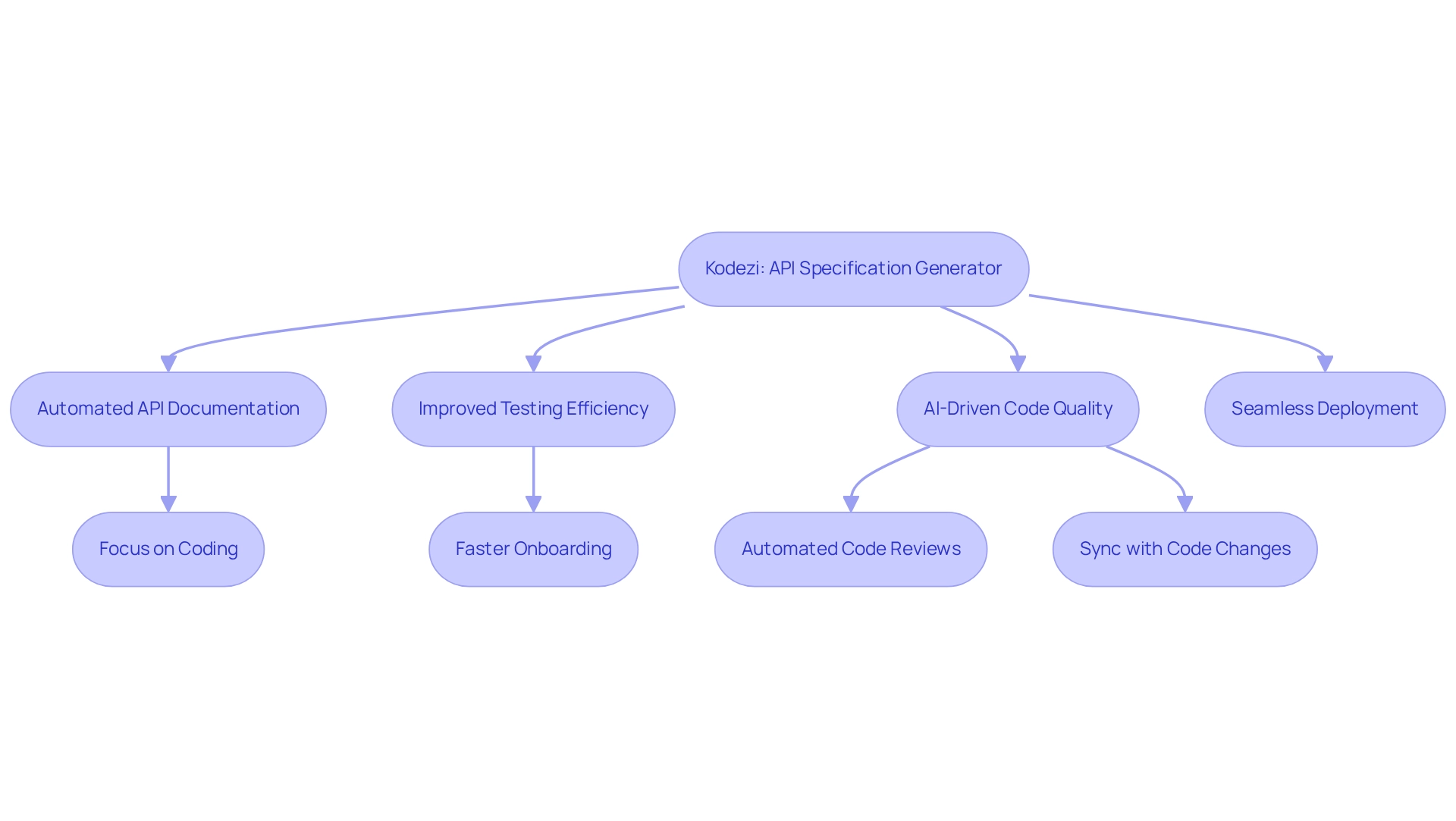
Planning: Establishing Objectives and Project Scope
In the planning stage of the components of SDLC, it is essential to establish clear objectives and define the project scope. Have you ever faced challenges in aligning your team on project goals? This process includes gathering requirements, identifying stakeholders, and setting realistic timelines, which are essential components of SDLC. Effective planning not only reduces uncertainty but also enhances predictability, which is crucial for optimal resource allocation and project management. Statistics indicate that 25% of executives and project managers highlight the significance of agile methodology expertise in achieving successful outcomes.
Tools like Kodezi can streamline the documentation of these objectives, ensuring that all team members are aligned from the outset. Furthermore, addressing challenges in project management—such as managing complex projects and ensuring effective communication—can significantly improve project success rates. By implementing best practices in project scope definition, teams can set a solid foundation for the components of SDLC in their development efforts. Ultimately, this leads to more successful project outcomes. Are you ready to explore how Kodezi can enhance your project management strategy?
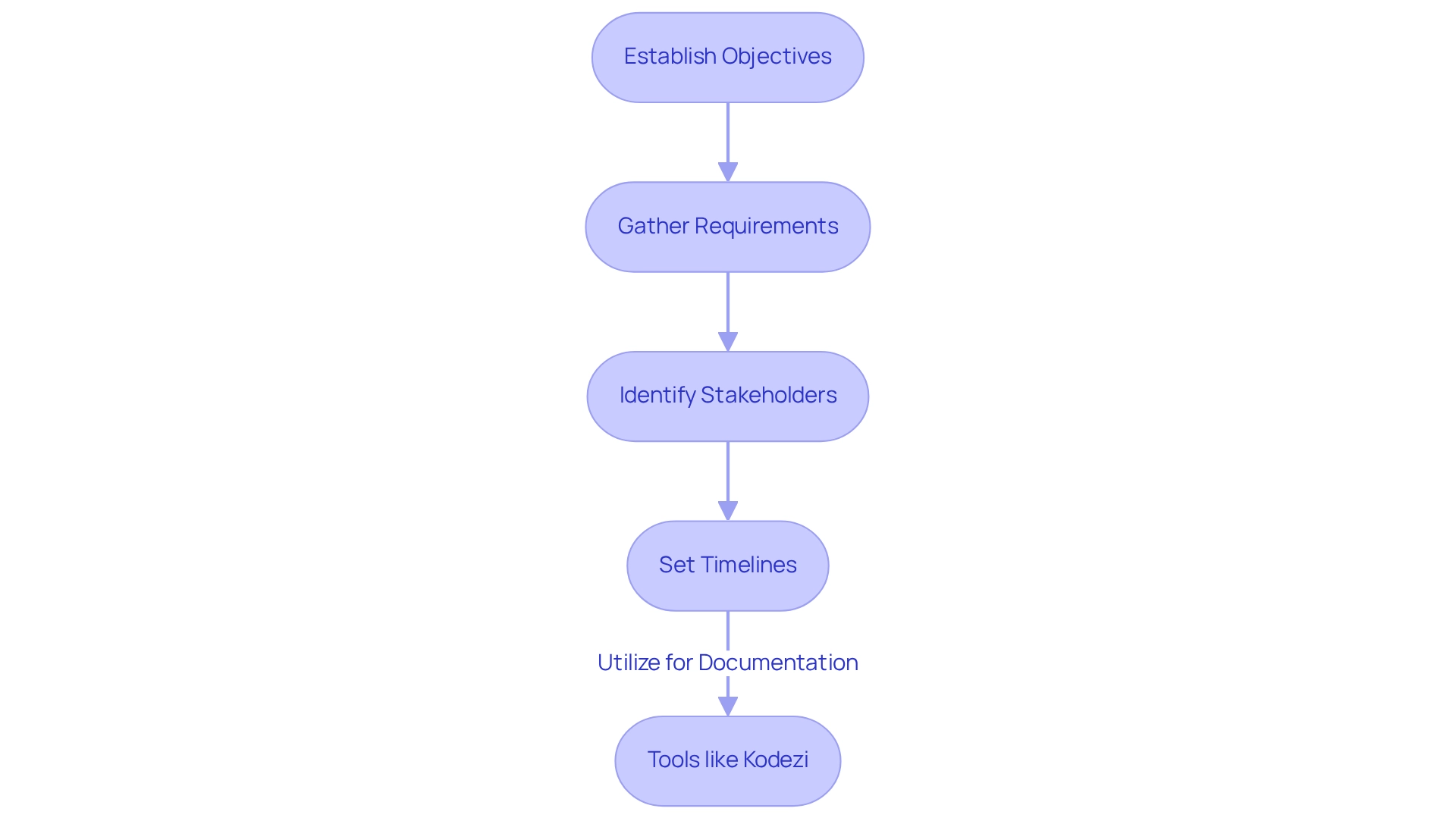
Design: Crafting the System Architecture
In the design phase, developers often encounter significant challenges, particularly in creating a detailed blueprint for the application that encompasses system architecture, data flow, and user interfaces. This phase is pivotal for ensuring the software's capability to accommodate future scalability and integration requirements. Misconfigured scalable systems can waste up to 40% of resources on overhead rather than meeting user demands. How can developers avoid such pitfalls? By utilizing Kodezi's platform features, including automated documentation and advanced optimization, they can significantly streamline the design process and reduce resource inefficiencies.
Furthermore, Kodezi ensures that the architecture complies with professional standards, enabling developers to craft user-friendly interfaces while maintaining high-quality programming. With advanced code optimization features, developers can swiftly resolve performance bottlenecks, identify security problems, and improve code formatting—all in seconds. As the demand for full-stack engineers skilled in both JavaScript and Python increases, utilizing tools like Kodezi becomes crucial for navigating current trends in application architecture design.
In addition, this method not only boosts productivity but also conforms to best practices for system architecture, ensuring that scalability and integration are seamlessly incorporated into the design. The case study 'Kodezi: Empowering Developers' emphasizes that the platform enhances developer productivity and programming quality, making it an essential resource in contemporary software development. Are you ready to explore the tools available on Kodezi and elevate your coding practices?

Development: Coding and Implementation
Coding challenges are a common hurdle for developers, often leading to inefficiencies and increased costs. During the development phase, programmers must convert design specifications into operational programming, and adhering to programming standards and best practices is crucial for ensuring quality and maintainability. Kodezi addresses these challenges with its advanced features, including AI-assisted tools for automatic programming correction, debugging, and optimization recommendations.
These tools not only simplify the coding process but also significantly enhance the overall quality of the software repository. By utilizing Kodezi's functionalities, developers can improve their productivity and ensure their work meets professional standards. Furthermore, expert perspectives underscore the necessity of upholding high programming standards. Robert C. Martin notes that while poor implementations can be rectified, they often come with substantial costs.
In addition, incorporating real-time code analysis tools like Kodezi is essential for fostering a culture of excellence in application development. This platform streamlines the coding process while safeguarding user privacy, making it a vital resource for developers seeking to enhance their efficiency and code quality. Are you ready to explore the tools available on Kodezi and elevate your coding practices?
Testing: Ensuring Quality and Functionality
The evaluation phase, as one of the components of SDLC, is crucial in addressing common coding challenges developers face. Various methodologies are employed to ensure that software functions as intended and meets established quality standards. Key methodologies, such as:
- Unit evaluations
- Integration assessments
- User acceptance evaluations
play a vital role in identifying and resolving issues early in the development process. How does Kodezi fit into this picture? Kodezi CLI serves as a versatile tool for B2B engineering teams, independently enhancing software quality and resolving issues before they reach production. Its automated evaluation features, including real-time bug detection and code analysis, significantly streamline this phase, drastically reducing the time and effort required for thorough assessments. By automating repetitive tasks, teams can focus on critical issues that enhance overall software quality.
In 2024, more than 60% of agile teams embraced behavior-driven development (BDD), showcasing a rising trend towards collaborative evaluation methods that improve communication among stakeholders. This trend aligns seamlessly with Kodezi's capabilities, as its automated assessment tools facilitate collaboration and efficiency in the evaluation process. The impact of automated evaluation on program quality is profound; it not only accelerates the assessment process but also enhances precision, resulting in fewer errors in production. For instance, utilizing a global network of testers can elevate software quality through expert bug detection and continuous evaluation methods, ultimately enhancing user experience and satisfaction while conserving time and costs.
Furthermore, methodologies like unit evaluation are essential for confirming that individual components function correctly before integration, thus preventing larger issues down the line. As Chris Launey, Principal Engineer at Starbucks, aptly noted, "Automation is an accelerator, not a replacement. It's about putting brains in your muscles." This perspective underscores the importance of integrating automated testing into the components of SDLC, especially through tools that have revolutionized debugging and enhanced productivity for over 1,000,000 users. Are you ready to explore how Kodezi can transform your development process?
Deployment: Releasing the Software to Users
The deployment phase marks a pivotal moment when applications are released to users, necessitating meticulous planning and execution for a seamless transition. This process typically encompasses:
- Configuring production environments
- Migrating data
- Delivering user training
Automation is essential during this phase; for example, utilizing Kodezi can significantly enhance deployment by automating documentation updates and ensuring compliance with all deployment protocols.
Expert insights underscore that effective documentation is crucial for deployment success, as it improves clarity and diminishes errors. In fact, statistics indicate that teams employing strong documentation practices achieve higher deployment success rates. Moreover, automating deployment processes not only expedites timelines but also reduces the risk of human error, promoting a more efficient workflow.
Best practices for deployment in 2025 involve:
- Comprehensive planning
- Ongoing monitoring
- Utilizing tools that facilitate smooth transitions
By focusing on these elements, teams can ensure that users experience minimal disruption and that the system operates as intended from day one. Continuous improvement, as demonstrated in case studies, reinforces the significance of measuring performance metrics to refine deployment strategies over time.
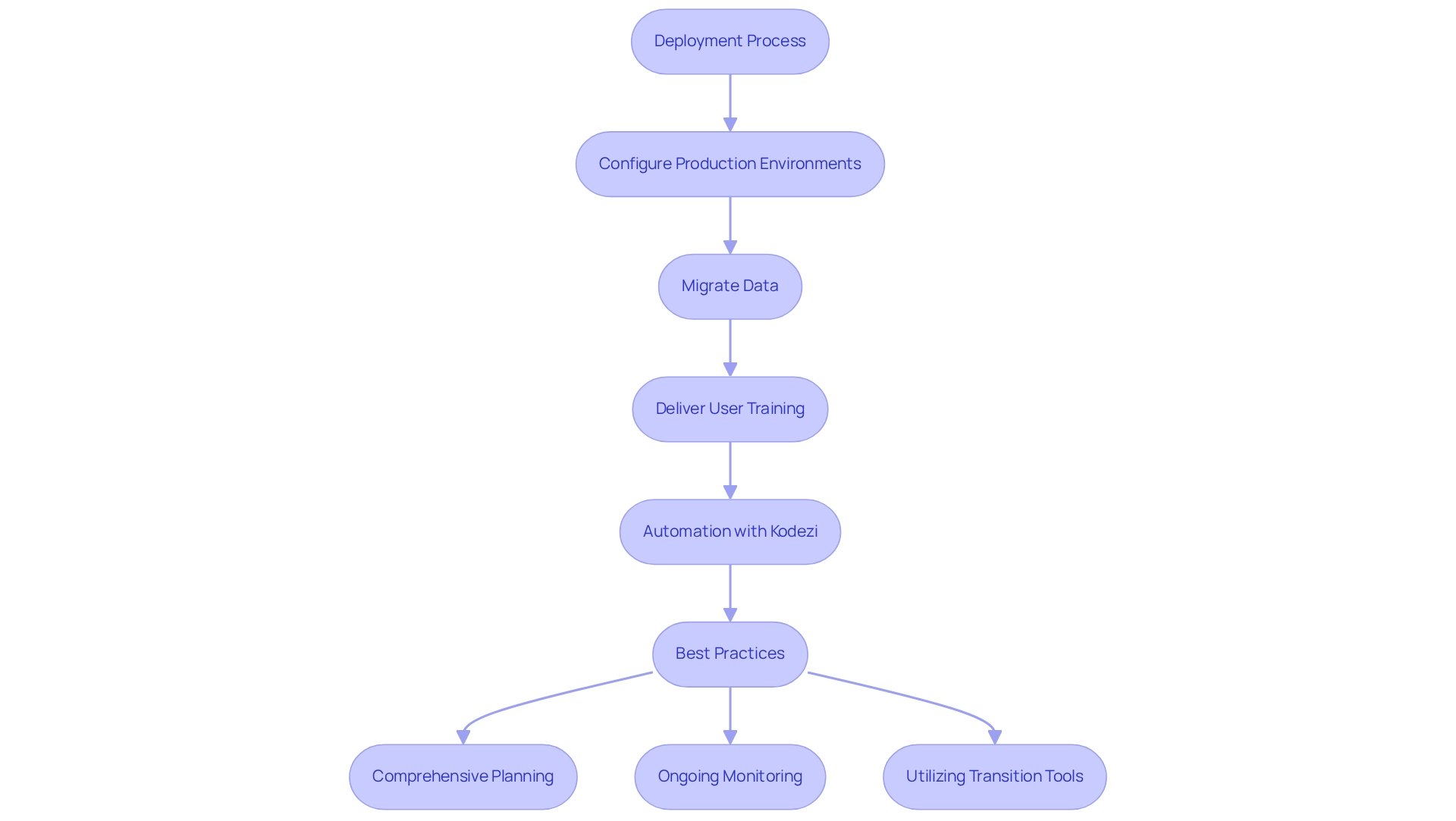
Maintenance: Ongoing Support and Improvement
The maintenance phase is essential for providing ongoing support to tackle issues that may arise post-deployment. It encompasses critical activities such as:
- Bug fixes
- Performance enhancements
- Updates to meet evolving user requirements
Did you know that maintenance costs can account for up to 70% of the overall application lifecycle expenses? This highlights the importance of efficient system maintenance. Tools like Kodezi's automated monitoring capabilities are vital in ensuring code quality and performance, enabling developers to swiftly identify and rectify issues. By leveraging such tools, teams can significantly enhance application efficiency and security throughout its lifecycle.
Furthermore, continuous support not only boosts user satisfaction but also dramatically reduces the time and costs associated with post-deployment fixes. For instance, case studies reveal that organizations with robust maintenance practices experience fewer issues and improved system performance, ultimately leading to a more reliable product. As the application landscape evolves, prioritizing maintenance and ongoing support becomes increasingly crucial for sustaining high-quality programs.
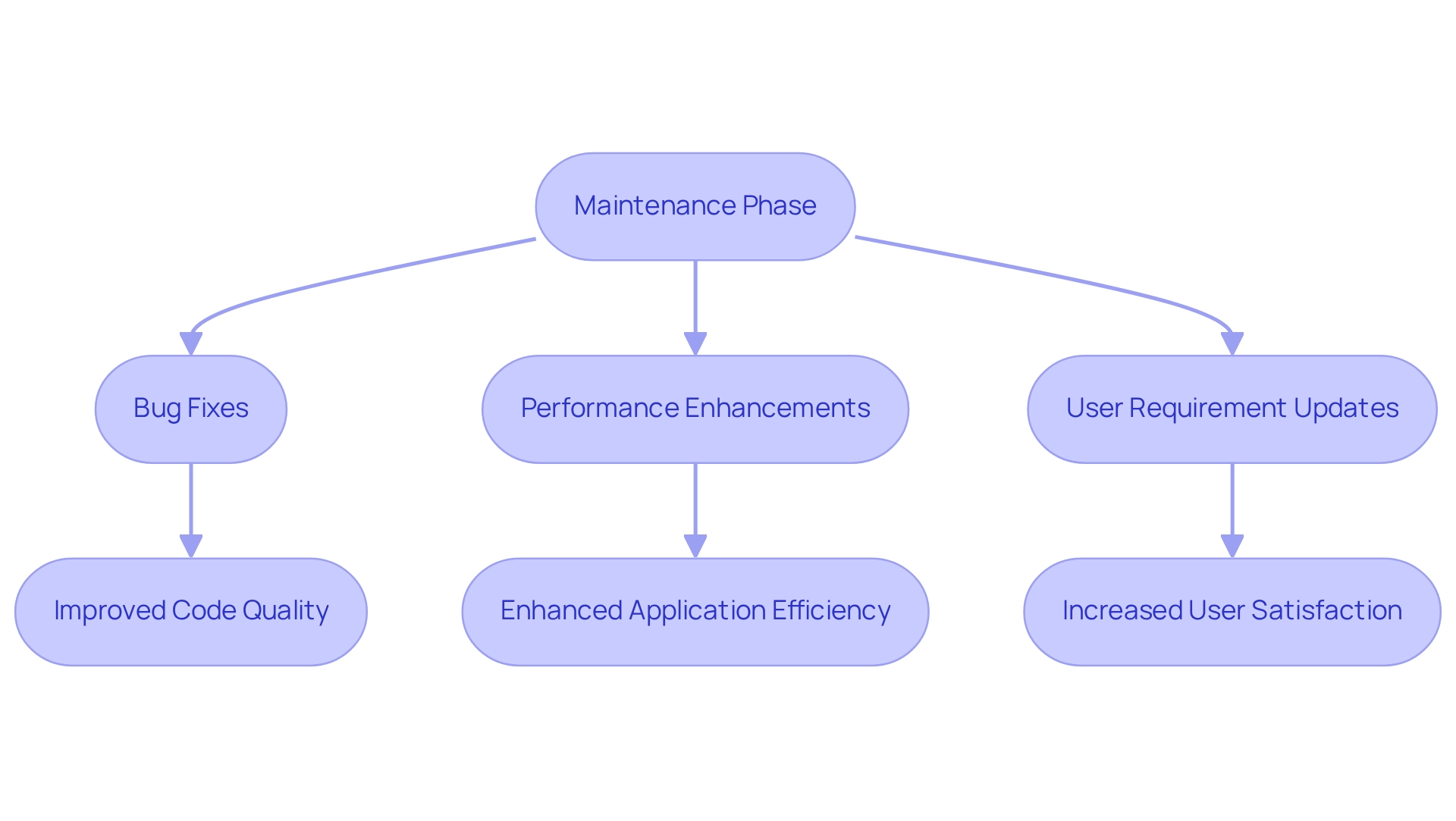
Agile Methodology: Embracing Flexibility and Iteration
Developers often encounter significant challenges in coding, particularly when it comes to maintaining quality and efficiency. Agile methodology prioritizes iterative development and continuous feedback, enabling teams to swiftly adapt to changes. This dynamic approach not only fosters collaboration but also significantly enhances product quality by integrating user feedback throughout the development cycle. In fact, organizations that embrace Agile practices report improved responsiveness to market demands and higher customer satisfaction.
So, how does Kodezi address these challenges? This platform aligns perfectly with Agile principles by offering tools that streamline rapid iterations and promote real-time collaboration among team members. With the enterprise application market projected to reach $344.4 billion by 2027, the need for tools that support Agile methodologies is more essential than ever. Furthermore, approximately 31% of enterprises support automation tools for cost reduction, which makes Kodezi's features in automating code troubleshooting and enhancement vital resources for Agile teams.
By leveraging Kodezi, developers can focus on delivering high-quality products while ensuring compliance with security best practices and coding standards. This not only boosts productivity but also enhances code quality, all while maintaining the flexibility that Agile demands. Are you ready to explore the tools available on the Kodezi platform and transform your coding practices?
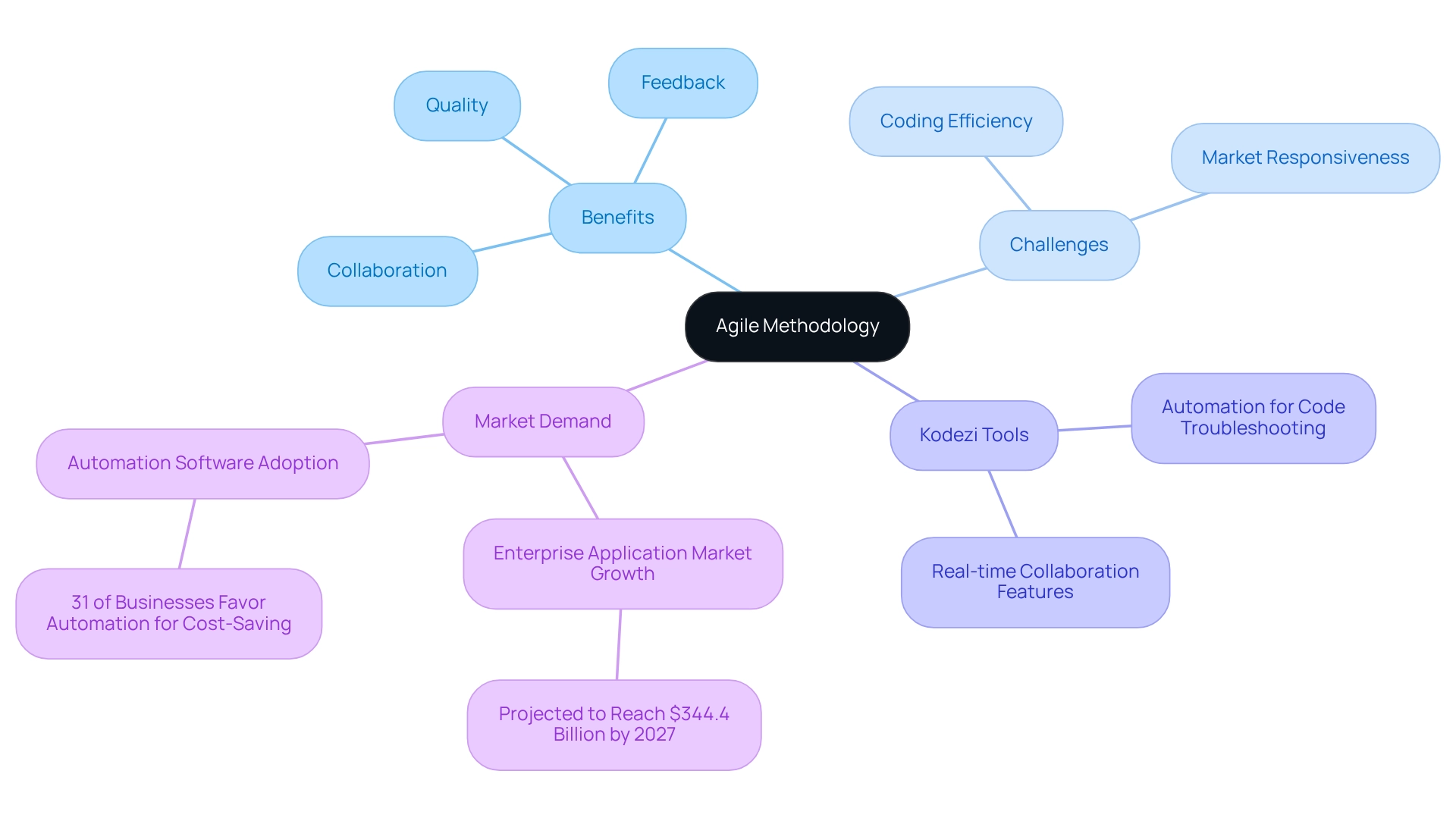
Security Integration: Protecting Software Throughout the Lifecycle
Security integration is essential in embedding protective measures throughout the development lifecycle, from initial planning to final deployment. This proactive approach enables teams to identify and address potential vulnerabilities early, significantly enhancing system resilience. Have you considered the cost of data breaches? In the United States, it averages $5.09 million, according to industry reports. Organizations that prioritize security during the components of SDLC can effectively reduce these costs.
Furthermore, tools like Kodezi play a pivotal role in this process, offering features that assist developers in adhering to best practices for secure coding. The system autonomously enhances your codebase by automating code debugging and optimization, ensuring that applications not only meet industry standards but are also fortified against emerging threats. In addition, incorporating security measures early in the development process has been shown to improve overall application quality and compliance, making it a vital focus for contemporary development teams.
As cybersecurity professionals emphasize, adopting a comprehensive approach to security—such as thorough API discovery and governance—can effectively mitigate risks associated with vulnerabilities. This includes identifying potential security gaps in APIs, which are increasingly targeted by malicious actors. Similarly, organizations must evaluate their security posture and budget before making cloud security decisions, ensuring that they allocate resources effectively to protect their applications.
By leveraging these insights and tools like Kodezi, developers can create robust applications that stand resilient against potential attacks. Are you ready to explore how Kodezi can enhance your coding practices and improve productivity? Discover the tools available on the platform today.

Best Practices: Optimizing the Software Development Lifecycle
In the ever-evolving landscape of software development, coding challenges are a common hurdle that many developers face. To efficiently enhance the components of SDLC, teams should adopt best practices such as:
- Regular program reviews
- Automated testing
- Continuous integration
How does Kodezi address these challenges? By providing an extensive set of tools designed to support these practices, Kodezi offers automated solutions for code quality checks, documentation, and testing.
These strategies not only encourage collaboration but also significantly improve quality and reduce defect rates. Research shows that regular review processes can lower defect rates by as much as 30%, highlighting their essential role in upholding high standards. Furthermore, by streamlining these processes, Kodezi empowers developers to focus on building robust solutions. This ultimately leads to more efficient and successful software development outcomes.
Imagine the productivity gains when development teams can minimize defects and enhance code quality. By leveraging Kodezi’s tools, developers can experience a significant boost in their workflow. Explore the tools available on the Kodezi platform and discover how they can transform your coding practices for the better.
Conclusion
In today's fast-paced software development landscape, developers face numerous coding challenges that can hinder productivity and code quality. The integration of Kodezi into the software development life cycle (SDLC) offers a transformative solution. Kodezi's AI-driven features streamline each phase, from planning to maintenance, allowing teams to concentrate on critical tasks rather than becoming bogged down by manual documentation and compliance requirements. By automating the creation of OpenAPI specifications and facilitating seamless collaboration, Kodezi empowers developers to produce high-quality software efficiently.
As organizations increasingly adopt Agile methodologies, the need for tools that support rapid iterations and real-time feedback becomes essential. Kodezi not only aligns with these practices but also enhances the development process with robust security measures, ensuring applications are resilient against emerging threats. The focus on best practices, such as regular code reviews and automated testing, illustrates how Kodezi boosts overall workflow efficiency.
Ultimately, leveraging Kodezi equips development teams with the necessary tools to navigate the complexities of modern software development. By alleviating the burdens of documentation and enhancing collaboration, Kodezi enables developers to innovate and remain competitive in an ever-evolving landscape. Embracing Kodezi transcends mere tool adoption; it signifies a commitment to elevating the standards of software quality and efficiency throughout the entire development life cycle.
Frequently Asked Questions
What challenges do developers face with API documentation?
Developers often encounter significant challenges in maintaining effective API documentation, which can hinder productivity and software quality.
How does Kodezi assist with API documentation?
Kodezi serves as a professional OpenAPI specification generator that automates the production of API documentation, allowing developers to focus on coding rather than manual documentation tasks.
What benefits does Kodezi provide for software quality and testing?
Kodezi improves testing efficiency and overall software quality by simplifying the documentation process and ensuring that the generated code adheres to professional standards.
What feature does Kodezi offer to enhance programming efficiency?
Kodezi includes a CLI tool that allows teams to swiftly AutoHeal codebases, which boosts programming efficiency and minimizes the time spent on pull requests.
How does Kodezi facilitate deployment?
Kodezi ensures effortless deployment as part of existing release processes, making updates seamless.
What specifications does Kodezi automatically generate for API testing?
Kodezi automatically generates OpenAPI 3.0 specs and Swagger UI for API testing, enabling effective team collaboration.
What impact do automation tools have on onboarding new developers?
Organizations leveraging automation tools experience a 22% faster onboarding process for new developers, according to statistics reported by Shopify.
What complexities do AI programming assistants introduce?
While AI programming assistants enhance productivity, they also introduce new complexities that developers must navigate.
Why is automated API documentation important according to industry leaders?
Industry leaders emphasize that automated API documentation is essential for upholding software quality and efficiency.
What additional features does Kodezi provide to improve workflow efficiency?
Kodezi automates code reviews and keeps API documentation in sync with code alterations, improving overall workflow efficiency.




